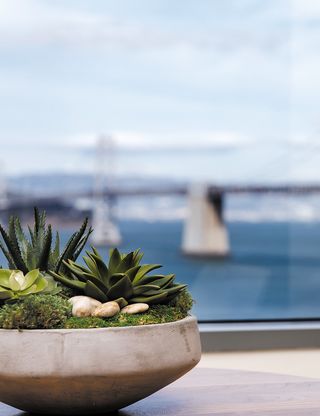History Of Golden Gate Bridge

Do you know why the Golden Gate Bridge has its iconic name? The answer might surprise you. Rather than being named for the area's association with the Gold Rush, it's actually named for the water that runs beneath it—The Golden Gate Strait. It's just one of the many historical facts about the Golden Gate Bridge that not too many people realize.
If you've been wondering about the interesting details that lay behind the Golden Gate Bridge's past, either because you've been thinking about moving to the area and have been looking for apartments in San Francisco or have a thirst for knowledge about the city, keep reading. We're going to delve into what you may not have realized about the history of the Golden Gate Bridge.
What's Up With That Name?
The aforementioned article gives us a deeper glimpse into the tale. During the mid-1800s, soldier and explorer John Fremont gave the passage its name, borrowing from the Greek term, "Chrysoplae." In English, it translates to "Golden Gate," which was fitting, as Fremont saw the similarities between San Francisco and another port town from antiquity:
"[when] John C. Fremont saw the watery trench that breached the range of coastal hills on the western edge of otherwise landlocked San Francisco Bay, it reminded him of another beautiful landlocked harbor: the Golden Horn of the Bosporus in Constantinople, now Istanbul."
Thus, the name for this gateway to the Pacific Ocean was born. Little did Fremont realize, however, that years later, the name would also be lent to the now-famous bridge that joins the sides of this mighty expanse.
What's The Story Behind Its Construction?
The idea for a bridge linking the two sides of the Golden Gate Strait goes back as far as the latter-1800s. Though ferry service had long been the established route from San Francisco to what is now known as Marin County, realizing a more practical connection between the would help expand growth. The idea had many detractors, including South Pacific Railroad company and Ansel Adams, but in spite of these protests (and the numerous lawsuits that were filed against the construction) the plan that sprung the Golden Gate Bridge into motion prevailed.
That plan, by the way, had its roots in a proposal that was published in the San Francisco Bulletin in 1916, by one-time engineering student turned journalist James Wilkins. The plan's price tag was exorbitant, $100 million (which would equate to a couple of billion dollars today) so San Francisco's city engineer, Michael M. O'Shaughnessy, put out a call to engineers to see if they could do it for less.
An engineer from Chicago, Joseph Strauss, jumped at the call. He was already skilled at constructing drawbridges, and after some collaboration with O'Shaughnessy, came to the conclusion that they could build a bridge across the Golden Gate Strait for only $30 million, a much more reasonable sum for the time.
They couldn't get to building straight away, however, as they would need funding and backing from the community. After creating the necessary sketches and designs in 1921, Strauss got to work trying to drum up support. These efforts paid off, and, according to History.com:
"By August 1925, the people of Marin, Sonoma, Del Norte and parts of Napa and Mendocino counties had agreed to join the district and offer their homes and businesses as collateral for securing funds."
Commencing construction was tied up for several years due to litigation and opposition. When the legal hurdles were surmounted and the last piece of the funding puzzle, an investment in the project by Bank Of America, was completed, Strauss and O'Shaughnessy were free to enact their grand vision. Construction finally began on January 5, 1933 when workers started excavating the sites for the bridge's towering anchorages.
They worked hard through many obstacles. Powerful storms disrupted the original timetable. New techniques had to be mastered to help speed construction. In the end, the team was able to complete the task in May of 1937, coming in both ahead of schedule and under budget.
Congratulations were in order. A one-week celebration was held to commemorate the amazing work that had been done. Strauss even wrote a poem (that is now part of the bridge) entitled "A Mighty Task Is Done," in honor of their accomplishments.
What's Happened Since It Was Built?
In the near-Century since the Golden Gate Bride's construction, it has stood tall as a monument to mankind's ingenuity. It has lasted through even the most devastating earthquakes that have occurred in the area, and was even named one of the "Seven Civil Engineer Wonders Of The United States" by the American Society of Civil Engineers. Until 1981, it was the longest suspension bridge in the world (at 4,200 feet). Until 1993, it was also the tallest (thanks to the 746-foot towers).
It sees more than its fair share of use. In addition to motor vehicle traffic, the bridge has pathways on both sides for pedestrians and cyclists. The bridge is even famous enough that it has its own visitor center and gift shop. Known as the Bridge Pavilion, those interested can take a peek on the San Francisco side of the bridge, near its southeast parking lot.
What's The Bridge's Legacy?
Though mighty indeed, there is a possibility for trouble in the Golden Gate Bridge's future. According to the National Park Service, "if global warming progresses at predicted rates, sea level could rise three feet or more by the end of this century. Historic buildings, archaeological sites, and roads will be threatened." The effects may not be limited to the environment, they might start to change outcomes that could influence the bridge's integrity as well. It's not a certainty, though, and there's also the possibility the bridge will be standing proud and tall well into San Francisco's future.
About Those Apartments In San Francisco...
They're one of the best ways to secure a spot in the city and get a peek at the Golden Gate Bridge for yourself. Rincon, located in Rincon Center, are one of the area's finest luxury offerings, replete with a wealth of things to do and see nearby, a fine selection of contemporary floor plans, fabulous building/resident amenities, and much more. This is a rental community done right. Come see for yourself, and make Rincon your choice for San Francisco living.









